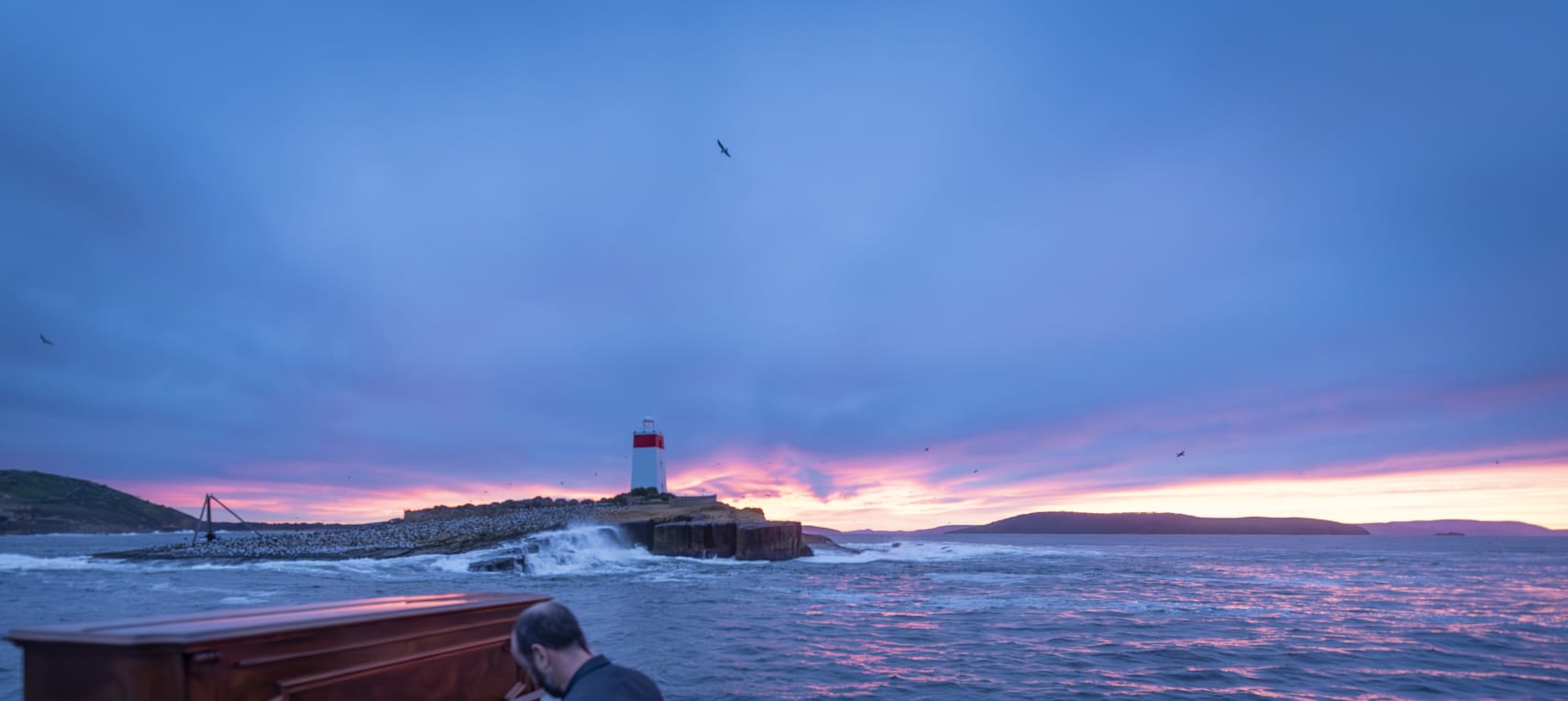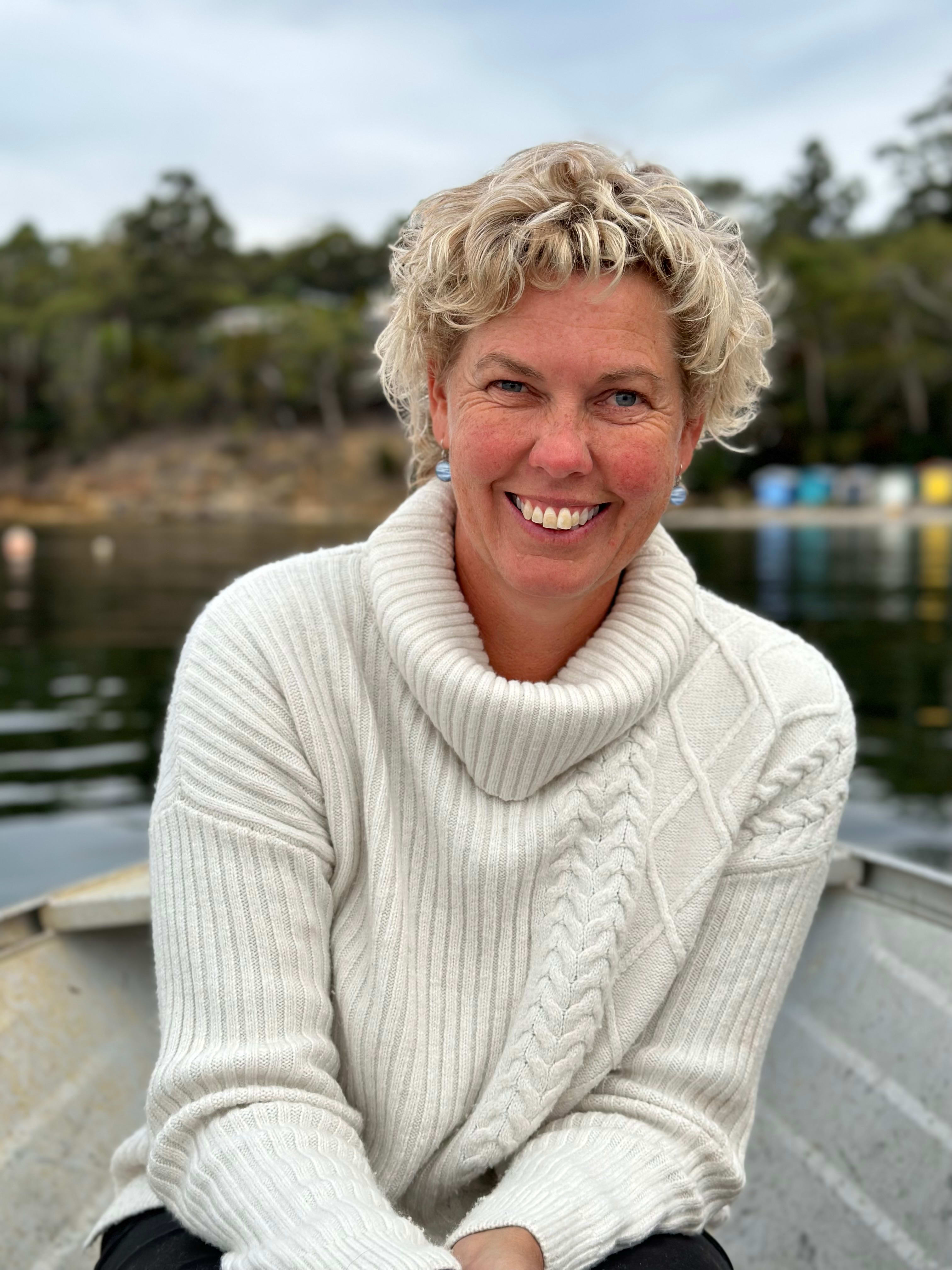Inspired by the movie soundtrack to the film The Piano, Kelvin Smith has gifted the world with beautiful piano music, played in equally beautiful places, since 2019. These pop-up concerts are unpublicised, so there are rarely more than a handful of first-hand witnesses. One such concert was played in a paddock, under an aurora, for the sole benefit of Rosie, Kelvin’s cow. An internet search of “A Piano of Tasmania” will pull up footage from plenty of past concerts, but experiencing one in person is something else.
When asked to write about Kelvin Smith’s most recent piano foray, I was filled with excitement and trepidation in equal parts. In the words of Hans Christian Andersen, “Where words fail, music speaks.” How does one describe the sensory flood and total connection felt when sound, salt and swell collide? To follow is my naïve attempt to articulate the indescribable, a morning most remarkable.
WHERE SOUND, SALT AND SWELL COLLIDE
musician and magician KELVIN SMITH
writer SONIA STRONG
photographer JASON BATEY, Retreats Photography
Transport PENNICOTT WILDERNESS JOURNEYS
At any given moment, something unique and marvellous is happening somewhere in Tasmania. On this particular winter’s morning, I find myself at one such intersection of time and space. Floating just off the Iron Pot, the oldest standing lighthouse tower in Australia, I am awash with anticipation. Alongside me are 16 other privileged human souls, a labrador retriever ... and a piano.
Breathing into cupped hands, we jiggle and shiver in beanies and down jackets, more in anticipation than an attempt to stay warm. It is 5.50am and my car tells me it’s one degree above freezing here at the Royal Yacht Club of Tasmania. The stars are sensibly tucked under a blanket of cloud. We exchange brief introductions, our breath visible as staccato puffs under the carpark’s yellow floodlights. It’s been raining for days and there’s more forecast, but right now Kelvin Smith has found the only suitable weather window we’ve had all week.
As the star of the show arrives, photographer Jason Batey, unloads an assortment of tripods, lens bags and drones. Having documented most of Smith’s adventures, Batey describes his friend as “just the right kind of crazy”.
This morning’s performance will take place on board one of Pennicott Wilderness Journey’s catamarans. Rob Pennicott’s plucky black lab, Myrtle, ushers us aboard. It is still dark as we cast off. Illuminated reflections of the marina’s many masts wobble across the smooth, black water.
Slightly starboard of centre, Smith’s Rönisch piano sits proudly up front, leading us down the D’Entrecasteaux Channel like some ghostly bowsprit. She is actually Smith’s second outdoor piano, his original Strauss now in retirement after many boat, crane and helicopter journeys left her worse for wear. The replacement is beginning to acquire similar badges of honour, enhancing her character. Her varnish is worn in places and there are sections where Smith is clearly in the process of sanding her back.
Like all great beauties, however, her true majesty lies in her story, her voice, her spirit, and what she has to offer the world.
. . .
When choosing outdoor locations to play, Kelvin Smith’s criteria are few. It needs only to be somewhere beautiful and interesting, logistical challenges seemingly of secondary concern. Previous performances have occurred at Parliament House, a deserted Port Arthur during Covid-19 lockdowns, suspended high above the Huon River on the Tahune Airwalk, on the wall of the Gordon River Dam and at various beaches and mountains across the state. He even has plans to push his piano to the top of kunanyi/Mt Wellington.
Today, we are heading for the Iron Pot, a tiny island at the mouth of the Derwent Estuary, and a lighthouse station (of sorts) since 1832. In true Tasmanian “just get it done” style, the first maritime warning light here was on a wooden stick, raised and lowered by hand by a single keeper and a couple of convicts living in tents.
Despite its proximity to Hobart, the island has a reputation as something of a rugged outpost. Tales persist of buildings washed away and storm-deposited kelp stranded in the lighthouse tower’s uppermost rails, more than 20 metres above sea level. Remarkably, given the tower’s wind and wave-battered location, it’s still standing. It was, in fact, the first lighthouse built in Tasmania, the first lighthouse to go solar and the first Australian lighthouse to use kerosene as an illuminant.
. . .
I take the helm briefly while Rob Pennicott checks our path for moorings, and ask him why he’s so generously facilitating Kelvin’s performance, presumably at some considerable expense. Smiling the same kid-like smile that Kelvin Smith is wearing, he says, “I just wanted it to happen. It’s a first for me.”
It is clearly a morning of many firsts, for I can say with some confidence that it is also the first time a colony of black-faced cormorants has been treated to a live piano performance. To their credit, they appear to appreciate the significance, dressing in black and white dinner suits for the occasion.
I wonder if it’s the first time a dog has rested his thumbless grip on a boat’s handrail and listened to Mariage d’Amour in the blue hour of dawn.
We hunch and squint in vain against the cold, as if that will somehow improve the temperature. Smith blows life into his hands, exhales and starts us off with the heart-wrenching piece, River Flows in You, by Yiruma. It seems an appropriate kind of prayer; a love song to the estuary, where fresh and salt water collide. Everything falls quiet as his first gentle notes are swept away. In between the wind-whisked screech of the kelp gulls, Smith’s deft fingers paint emotive images on the silence.

Although I feel he is also playing to the more than human audience today, Smith says he has one main objective when he plays outdoors. He wants to remind people of how beautiful this place is, but he says his biggest hope is that “people will just look at what I’m doing and smile”. As I look around at the closed eyes and inwardly turned attention of everyone on board, although no one is actually looking at Smith, we are all most certainly smiling. Even two-year old Augie is peacefully entranced.
I feel on the verge of tears, such is the shared beauty and power of this moment. It is simultaneously a connecting and solitary experience. I overhear one of our number murmur that this moment is making her heart hurt … in a good way.
This is the full sensory experience. The music seeps into my ears and heart, and my skin is pink and alive with the pricking salt-spray. I can taste it. We steady ourselves and try to anticipate the vessel’s movement through three dimensions. As the music reaches a crescendo, hundreds of seabirds suddenly take to the air around the piano. The pungent presence of our friends on the wing is welcome, as they wheel and cry in rhythm with Kelvin’s playing. The arc of their dip and soar parallels the pulse of the music and the push-pull of the southerly swell.
Gulls, ocean, music – all breathing as one; a singular moment of perfect harmony. It feels as if Kelvin Smith is serenading all the wild things, human and animal woven together in his playing.
The light is different now. The clouds have lifted and the wind has picked up. Smith wraps his hands briefly around a couple of pocket-sized hand warmers, which don’t seem up to the task. I feel I could listen as long as his fingers hold out. The break in proceedings permits some enraptured whispering and hot water bottles emerge from under padded jackets to be handed around. I am grateful there are people in this world so prepared to think of such things, despite the early hour and unusual circumstances.
On the very end of South Arm peninsula sits a lone building, perhaps a residence. If anyone’s home, Pachelbel’s Canon in D must be failing to reach them in this northerly, blowing Smith’s music out past temeteletta/Betsey Island. I imagine the island’s seals and penguins catching a whiff of music on the wind, politely ceasing their raucous jostling and turning appreciative heads toward the Iron Pot.
The sun is drawing a bright band of colour above the ocean, now turbid teal and white. A couple of birds perch on the stave of the vessel’s railing like notes. Ludovico Einaudi’s Nuvole Bianche (White Clouds) is next. Today, it could appropriately translate as white water however, as the intensity of the sea has increased in parallel with the music. Abruptly, Smith stops playing, reaches forward and holds his piano steady as a large wave catches us. We pitch wildly in its backwash off the rocky island, vertical spray creating a dramatic backdrop. As the risk of her tipping passes, Smith laughs, a little nervously, fingers finding their way intuitively back into position.
I can’t help but feel, despite its weight and size, and the inherent risks that accompany such dimensions, that the piano is actually an outdoor instrument. She feels at home here, her music expanding to fill the infinite space.
We are forced back into more sheltered waters and the Rönisch is once more tethered. I am elated yet melancholy, expansive yet reflective. I have too many emotions to contain. There is a transcendent and transformative power both in music and in wild nature, the combination of which has shifted something within me.
Some dapper poet with the impressive name of Henry Wadsworth Longfellow is quoted as saying, “Music is the universal language of mankind.” I prefer to drop the last two words, for I believe the several thousand seabirds sitting in respectful rows felt the same vibrations as I; wild things and wild sounds alike, organised into temporary civility.
What I am certain of, is that Kelvin Smith’s kind of crazy is the most sane thing I’ve witnessed in a very long time. It is exactly the kind of madness the world needs.

Sonia Strong moved to Tasmania in 2005 and lives in the forested hills of the D’Entrecasteaux Channel. She has worked in conservation and alpine/marine park management, as a paramedic and recently, as a wilderness ranger. She is also a metalsmith, writer and painter. She has a deep affection for windswept and interesting people and places and is happiest when creating, immersed in a creek looking for sapphires, exploring wild places or in the sunshine with wine and friends. Sonia has published several children’s books through Forty South, including “Tazzie The Turbo Chook Finds Her Feet”. You can follow her on Instagram, @soniastrongartist.








